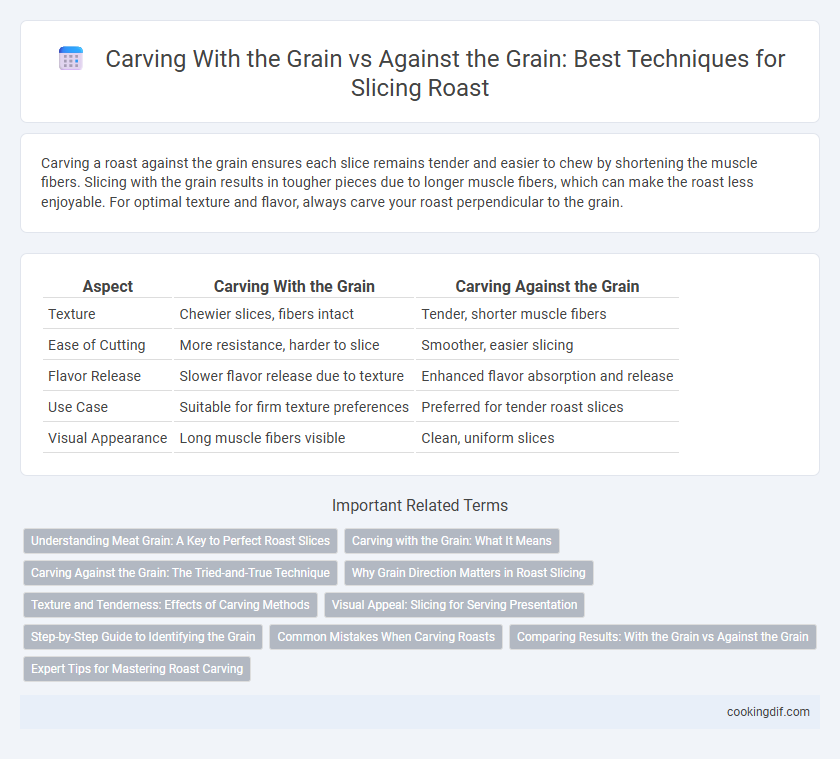Carving a roast against the grain ensures each slice remains tender and easier to chew by shortening the muscle fibers. Slicing with the grain results in tougher pieces due to longer muscle fibers, which can make the roast less enjoyable. For optimal texture and flavor, always carve your roast perpendicular to the grain.
Table of Comparison
| Aspect | Carving With the Grain | Carving Against the Grain |
|---|---|---|
| Texture | Chewier slices, fibers intact | Tender, shorter muscle fibers |
| Ease of Cutting | More resistance, harder to slice | Smoother, easier slicing |
| Flavor Release | Slower flavor release due to texture | Enhanced flavor absorption and release |
| Use Case | Suitable for firm texture preferences | Preferred for tender roast slices |
| Visual Appearance | Long muscle fibers visible | Clean, uniform slices |
Understanding Meat Grain: A Key to Perfect Roast Slices
Slicing roast meat with the grain results in longer fibers and a chewier texture, while carving against the grain shortens muscle fibers, yielding tender and easy-to-chew slices. Understanding the direction of the meat grain is essential for optimal roast presentation and enhanced eating experience. Mastering this technique ensures each slice maximizes juiciness and tenderness by disrupting the natural muscle fibers.
Carving with the Grain: What It Means
Carving a roast with the grain means slicing parallel to the muscle fibers, preserving their length and texture; this method often results in chewier slices. Cutting with the grain maintains the integrity of the meat fibers, which can be beneficial for firmer cuts but may reduce tenderness. Understanding how to carve with the grain helps optimize the roast's texture and eating experience based on the specific cut of meat.
Carving Against the Grain: The Tried-and-True Technique
Carving roast against the grain is the tried-and-true technique that ensures tender, easy-to-chew slices by cutting through muscle fibers rather than parallel to them. This method breaks down the tough strands, enhancing both texture and flavor in each bite. Professional chefs consistently recommend carving against the grain for optimal roast tenderness and mouthfeel.
Why Grain Direction Matters in Roast Slicing
Carving a roast with the grain results in longer, tougher meat fibers that require more effort to chew, while slicing against the grain shortens these muscle fibers, producing tender, easier-to-eat pieces. The grain direction in cuts like brisket or flank steak reveals the alignment of muscle fibers, and cutting perpendicular to this orientation breaks down connective tissues more efficiently. Understanding and following the grain direction enhances texture and juiciness, maximizing the roast's flavor profile and overall dining experience.
Texture and Tenderness: Effects of Carving Methods
Carving roast meat with the grain results in longer muscle fibers, producing a chewier texture and less tenderness. Slicing against the grain cuts through the muscle fibers into shorter segments, enhancing the meat's tenderness and making it easier to chew. This method optimizes the roast's texture by breaking down connective tissue and improving overall mouthfeel.
Visual Appeal: Slicing for Serving Presentation
Carving roast meat with the grain results in longer, tougher slices that may appear less tender and visually appealing. Slicing against the grain breaks muscle fibers, producing shorter, more uniform pieces that showcase a tender texture and an attractive, clean edge. This technique enhances the roast's overall presentation, making each slice look succulent and inviting for serving.
Step-by-Step Guide to Identifying the Grain
Identifying the grain in a roast starts by examining the muscle fibers, which run parallel in one direction, visible as lines or striations on the surface. To carve with the grain, slice parallel to these fibers, producing chewier pieces, while carving against the grain means cutting perpendicular to fibers, yielding more tender slices. Use a knife to gently score the surface, revealing the grain's orientation, then adjust your slicing direction accordingly for optimal texture and tenderness.
Common Mistakes When Carving Roasts
Carving a roast against the grain results in tougher, chewier slices, while slicing with the grain can cause stringy, uneven pieces that are less enjoyable. Common mistakes include failing to identify the direction of the muscle fibers before cutting and using excessive force, which damages the texture of the roast. Proper technique involves locating the grain and slicing perpendicular to it, ensuring tender, easy-to-chew servings.
Comparing Results: With the Grain vs Against the Grain
Carving a roast with the grain results in longer, chewier slices that highlight the muscle fibers, making the meat tougher to chew. Slicing against the grain breaks up the muscle fibers, producing shorter, more tender slices that are easier to eat. For optimal tenderness and flavor release, cutting against the grain is preferred when serving roast meat.
Expert Tips for Mastering Roast Carving
Carving a roast with the grain results in longer slices that showcase the meat's natural texture, while slicing against the grain produces tender, bite-sized pieces by breaking down muscle fibers. Experts recommend identifying the grain's direction carefully before carving to ensure optimal juiciness and tenderness in every slice. Using a sharp carving knife and steady, even strokes enhances precision and maintains the roast's structural integrity.
Carving with the grain vs against the grain for roast slicing Infographic

 cookingdif.com
cookingdif.com